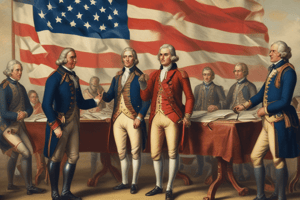Podcast
Questions and Answers
What year was the Oregon Treaty signed?
What year was the Oregon Treaty signed?
1846
Which agreement limited the kind of naval ships allowed on the Great Lakes?
Which agreement limited the kind of naval ships allowed on the Great Lakes?
The Rush-Bagot Agreement.
Which purchase allowed the USA to expand westward?
Which purchase allowed the USA to expand westward?
The Louisiana Purchase.
Which two individuals came to an agreement about ships on the Great Lakes?
Which two individuals came to an agreement about ships on the Great Lakes?
What is the name of the boundary line that runs to the Rocky Mountains?
What is the name of the boundary line that runs to the Rocky Mountains?
From which region was immigration to Upper Canada and the west primarily coming?
From which region was immigration to Upper Canada and the west primarily coming?
How many naval ships were allowed per country on Lake Champlain under the Rush-Bagot Agreement?
How many naval ships were allowed per country on Lake Champlain under the Rush-Bagot Agreement?
What was the main consequence for English and French relations in Lower Canada post-War of 1812?
What was the main consequence for English and French relations in Lower Canada post-War of 1812?
Which American states were part of the new Oregon Territory?
Which American states were part of the new Oregon Territory?
Why did Great Britain begin to respect the USA more after the War of 1812?
Why did Great Britain begin to respect the USA more after the War of 1812?
Flashcards are hidden until you start studying
Study Notes
The Boundary Between Canada and the USA
- The boundary between the USA and Canada was partly agreed upon after the American Revolutionary War.
- The boundary runs through the state of Maine, separating Quebec from Maine, and then moves down the middle of the St. Lawrence River into Lake Ontario, splitting the lake in half for both countries.
- It continues through Lake Erie and the Niagara River, giving each country a part of the famous waterfall.
- The boundary then carries on through Lakes Huron and Superior, splitting them in half until it reaches the area just south of modern-day Thunder Bay.
- From there, the boundary uses the 49th parallel of latitude from Lake of the Woods in Ontario to the Rocky Mountains.
- The Oregon Treaty of 1846 settled the boundary line, continuing along the 49th parallel to the sea.
No More Warships on the Great Lakes
- The Rush-Bagot Agreement in 1817 limited the kinds of naval ships allowed on the Great Lakes.
- Neither country was allowed more than one naval ship on Lake Champlain and no more than two ships per country on the upper Great Lakes.
- Each ship was only allowed to have one gun.
- The Agreement has been changed slightly, but still remains in effect today.
Immigration
- Immigration from the USA to Upper Canada was discouraged.
- Large numbers of immigrants started coming to North America, with many initially deciding to go to the USA.
- For a long time, immigration to Upper Canada and farther west came from the British Isles: England, Scotland, Ireland, and Wales.
The USA Gains the Respect of Great Britain
- The USA had fought Britain twice in less than 50 years and had not been defeated.
- The War of 1812 had no winners.
- The USA was now recognized as an independent country, and Americans and the British, having a common heritage, were to become and remain close allies.
The USA Expands West and South
- The USA now looked west and south to expand, rather than to the north.
- The Louisiana Purchase had been bought from France, providing land west of the Mississippi.
- Americans and new immigrants soon started heading into this area in search of new farmland.
- The USA then sought land owned by Spain, including California, Texas, and New Mexico.
Canada Looks At Itself Differently
- Lower Canada began to look at itself differently after the War of 1812.
- The English and French had fought side by side against a common enemy, defending Canada.
- While Britain may not have been a perfect choice for the Quebecois, at least they still had their language and culture.
- The long march by John Le Couteur and his 450 soldiers from New Brunswick to Ontario proved that the colonies in the Maritimes felt themselves to be part of Upper Canada.
Studying That Suits You
Use AI to generate personalized quizzes and flashcards to suit your learning preferences.




